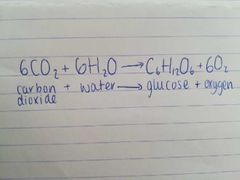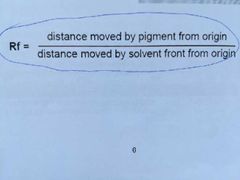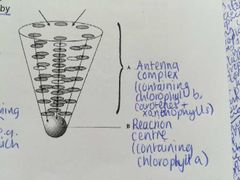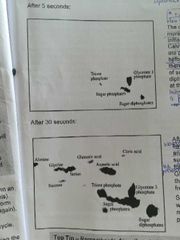![]()
![]()
![]()
Use LEFT and RIGHT arrow keys to navigate between flashcards;
Use UP and DOWN arrow keys to flip the card;
H to show hint;
A reads text to speech;
51 Cards in this Set
- Front
- Back
|
Define photosynthesis |
Photosynthesis is the process by which carbohydrates are synthesised from carbon dioxide and water, using light energy as an energy source |
|
|
Summary equation for photosynthesis |

|
|
|
Where does photosynthesis take place? |
In chloroplasts |
|
|
Structure of a chloroplast |

|
|
|
What do chloroplasts contain to help with photosynthesis? |
Photosynthetic pigments (e.g. chlorophyll a and b, carotene and xanthophylls) which absorb light energy at particular wavelengths of light. |
|
|
Name four photosynthetic pigments |
Chlorophyll a Chlorophyll b Carotene Xanthophylls |
|
|
Where are chloroplasts found? |
In mesophyll tissues, especially in the palisade mesophyll cells |
|
|
Leaf and chloroplast adaptations for photosynthesis |
1) thin leaves so that light can penetrate right through and so there are short diffusion pathways for carbon dioxide 2) transparent cuticle and upper epidermis so that light can pass through 3) air spaces in the spongy mesophyll layer so that carbon dioxide can diffuse to photosynthesising cells 4) abundance of chloroplasts in the palisade mesophyll layer 5) chloroplasts can orientate themselves so that in low light conditions they can spread out to absorb as much light energy as possible or in high light conditions they can line up in columns to prevent damage by over-exposure 6) chloroplasts contain many grana so that there is a high surface area for the photosynthetic pigments |
|
|
Chromatography use |
Used to separate photosynthetic pigments |
|
|
How chromatography identifies photosynthetic pigments |

Chromatography separates photosynthetic pigments which can be identified by looking at their relative positions on a chromatogram and calculating their Rf values. Their calculated Rf values can then be compared to known Rf values to identify the pigment. |
|
|
How to calculate Rf? |

|
|
|
What is an absorption spectrum? |
It is a graph that shows how much light has been absorbed by a pigment at different wavelengths of light. Different pigments have different absorption peaks (e.g. chlorophyll a = blue and red) |
|
|
What is an action spectrum? |
It is a graph to show the rate of photosynthesis at different wavelengths of light |
|
|
What would you expect to find if you overlayed an absorption spectrum and an action spectrum graph and what does this suggest? |
A very close correlation which would suggest that the wavelengths of light absorbed by photosynthetic pigments are used for photosynthesis |
|
|
What did Thomas Englemann do? |
He used algae spirogyra, motile aerobic bacteria and a prism to refract light to determine which wavelengths of light are used the most for photosynthesis |
|
|
What did Thomas Englemann conclude? |
Oxygen is a product of photosynthesis and will be produced most in at the wavelengths of light most used for photosynthesis. Aerobic bacteria need oxygen to respire and so will migrate towards regions with a higher concentration of oxygen. Englemann concluded that the regions of the spectrum which had the most photosynthetic activity were the blue and red regions. |
|
|
Define light harvesting |
The process by which photosynthetic pigments absorb light energy |
|
|
How is light harvesting achieved? |
It is achieved by antenna complexes within the thylakoid membrane of the chloroplasts |
|
|
Structure and description of the antenna complexes |

There is a reaction centre at its base containing a primary pigment e.g. chlorophyll a and then an antenna complex containing all the other pigments e.g. chlorophyll b, carotenes and xanthophylls. This allows for a range of wavelengths to be absorbed. |
|
|
Leaf tissue structure |

|
|
|
What are the two stages of photosynthesis and where do they occur? |
Light dependent stage (in the thylakoids) Light independent stage (in the stroma) |
|
|
Why is chlorophyll a known as a 'primary pigment'? |
Because it is directly involved in the conversion of light energy (photons) to chemical energy |
|
|
What is a photon? |
Light energy |
|
|
Define phosphorylation |
The process by which a phosphate group is added to ADP to from ATP |
|
|
Define photophosphorylation |
A process which requires light energy to add a phosphate group to ADP to form ATP |
|
|
How does the light dependent stage begin? |
Light energy hits the top of the antenna complex and is passed from accessory pigments to the primary pigments at the reaction centre. Proteins associated with the antenna complex prevent light energy escaping for the antenna complex. |
|
|
What does the reaction centre consist of and what are the two types of reaction centre? |
The relation centre consists of two chlorophyll a molecules (primary pigments) which absorb light energy and release high energy electrons There are two types of reaction centre 1) photosystem I (PSI) which has an absorption peak of 700nm and 2) photosystem II (PSII) which has an absorption peak of 680nm |
|
|
Briefly describe what happens when photons of light reach the reaction centre |
Photons of light passed to chlorophyll a molecules excite electrons and raise them to a higher energy level. These high energy electrons are passed to an electron acceptor and will either be used for ATP synthesis via photophosphorylation or to produced reduced NADP. |
|
|
What are the 2 types of photophosphorylation? |
1) cyclic photophosphorylation 2) non-cyclic photophosphorylation |
|
|
Describe cyclic photophosphorylation |
Cyclic photophosphorylation involves PSI only. High energy electrons pass from PSI to an electron acceptor. They are then donated to the electron transport system to generate a proton gradient for chemiosmosis which results in the formation of ATP from ADP and Pi. The electron is then passed back to PSI. This is a cyclic pathway as the electron returns to its origin - PSI. |
|
|
Describe non-cyclic photophosphorylation |
Non-cyclic photophosphorylation involves both PSI and PSII. 2 high energy electrons from PSI (along with 2 hydrogen ions from photolysis) are passed to NADP to form reduced NADP. PSI is now an electron short and has a positive charge. PSII passes a high energy electron to the electron transport system to generate a proton gradient for chemiosmosis, resulting in the formation of ATP from ADP and Pi. This electron is then passed to PSI. This is a non-cyclic pathway as the electron is not returned to its origin. PSII is now an electron short. |
|
|
Describe photolysis |
Photolysis provides an electron for PSII. Water molecules in the thylakoid space absorb light energy and are split into electrons, protons (hydrogen ions) and oxygen. Electrons are passed to PSII to replace those lost during non-cyclic photophosphorylation. Protons (along with electrons) are used to reduce NADP. Oxygen is diffused out of the chloroplast as a waste product. |
|
|
Define photolysis |
Photolysis is splitting water by light energy, producing electrons, protons and oxygen. The water molecules used for photolysis are found in the thylakoid space. |
|
|
Draw a suitable diagram to show non-cyclic photophosphorylation |

|
|
|
What are the products of the light dependent stage of photosynthesis? |
ATP - energy source Reduced NADP - reducing power Oxygen which is diffused out of the chloroplast as a waste product |
|
|
Why is the ATP and reduced NADP produced in the light dependent stage of photosynthesis essential for the life of a plant? |
Without these, the Calvin cycle will stop. Carbon dioxide will not be fixed into carbohydrate and there will be no glucose for respiration. The plant will therefore die. |
|
|
What occurs in the light independent stage of photosynthesis? |
The Calvin cycle |
|
|
What does the Calvin cycle do? |
Fixes carbon dioxide into carbohydrate |
|
|
Describe the Calvin cycle |
Carbon dioxide is taken up by 5C ribulose biphosphate (RuBP) to form an unstable 6C molecule and then 2 stable 3C glycerate-3-phosphate molecules. This is all catalysed by the enzyme rubisco. The carbon dioxide has now been 'fixed' into carbohydrate. ATP and reduced NADP reduce the 2 3C GP molecules to form 2 3C triose phosphate (TP) molecules. Most of the TP is converted to RuBP - this regeneration allows the cycle to continue. The remaining TP is converted to either carbohydrates (glucose then to starch) or amino acids (with the addition of nitrogen) and subsequently proteins. |
|
|
Diagram of the Calvin cycle |

|
|
|
What is an autoradiograph used for? |
To show products derived from the Calvin cycle using chromatography to separate the radioactive compounds. |
|

How to interpret an autoradiograph |
The larger and darker the spots, the more of the compound present. Initially more glycerate-3-phosphate would be present than triose phosphate as it is formed first in the cycle. After some time, more GP and TP will be produced (producing larger and darker spots) and also other molecules such as amino acids (as they take longer to form) |
|
|
What are limiting factors for photosynthesis? |
Water and Carbon dioxide Light intensity Temperature |
|
|
Why are water and carbon dioxide limiting factors for photosynthesis? |
They are needed as reactants |
|
|
Why is light intensity a limiting factor for photosynthesis? |
Needs sufficient light intensity at suitable wavelengths to excite electrons in the photosystems in the light dependent stage |
|
|
Why is temperature a limiting factor for photosynthesis? |
An optimal temperature is needed so that kinetic energy is formed which will affect the rates of transport and enzyme activity |
|
|
How will a limiting factor e.g. carbon dioxide affect a graph? |
As light intensity increases, the rate of photosynthesis increases until it reaches the saturation point where the carbon dioxide limits the rate of photosynthesis, causing it to plateau. |
|
|
Define a limiting factor |
A factor which limits the rate of a physical process e.g. photosynthesis |
|
|
Two types of inorganic ions and examples |
Macronutrients e.g. sodium, magnesium, calcium, nitrate and phosphate are needed in small amounts Micronutrients e.g. manganese and copper are needed in tiny amounts |
|
|
Describe the role of the macronutrient nitrogen in plants |
Nitrogen is absorbed by plant roots via active transport. It is then transported around the plant as nitrates in the xylem and as amino acids in the phloem. It is used for the synthesis of nucleotides such as ATP and amino acids. A nitrogen deficiency causes the reduced growth of plant organs and chlorosis (the yellowing of plant leaves) which is caused by the reduced production of chloroplasts. Chlorosis first appears in older leaves. |
|
|
Describe the role of the macronutrient magnesium in plants |
Magnesium is absorbed as Mg²+ and is transported via the plants xylem. It is used to form chlorophyll and activate ATPase. A magnesium deficiency would lead to chlorosis due to reduced chlorophyll. Chlorosis would start at the veins of older leaves as magnesium gets transported to new leaves. |

